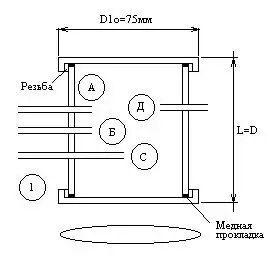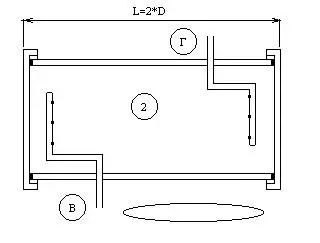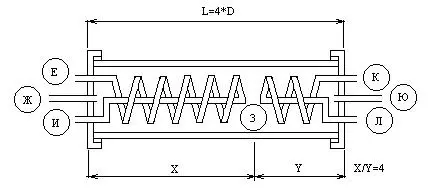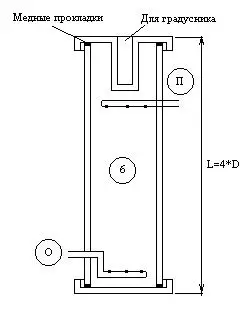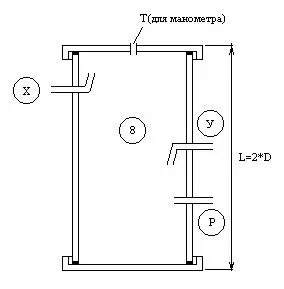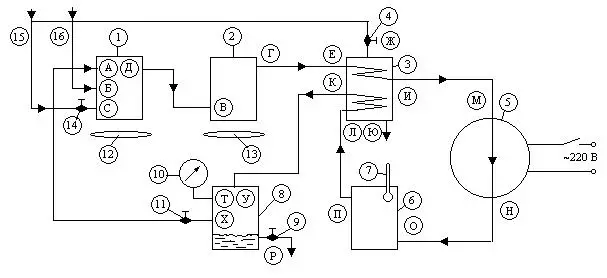Obtaining fuel from natural gas
General description:
The liquid obtained by this description is methanol (methyl alcohol). Methanol in pure form is used as a solvent and as a high-octane additive to engine fuel, as well as the highest octane (octane number is 150) gasoline. This is the same gasoline, which fills the tanks of racing motorcycles and cars. As foreign studies are shown, the engine running on methanol, serves many times longer than when using conventional autobannya, its power rises by 20% (with a constant engine unchanged). The exhaust of the engine operating on this fuel is environmentally friendly and when checking it on toxicity, harmful substances are practically absent.
A small-sized device for obtaining this fuel is easy to manufacture, does not require special knowledge and scarce parts, trouble free in operation. Its productivity depends on various reasons, including the dimensions. The device, the scheme and the description of the assembly of which we bring to your attention, with d = 75mm gives three liters of finished fuel per hour, has a weight of about 20 kg, and the dimensions are approximately: 20 cm in height, 50 cm long and 30 cm in width.
ATTENTION: Methanol is a strong poison. It is a colorless liquid with a boiling point of 65 ° C, has a smell similar to the smell of ordinary drinking alcohol, and mixed in all respects with water and many organic fluids. Remember that 30 millilitres of drunk methanol are fatal!
Principle of operation and work of the device:
The tap water is connected to the "water input" (15) and, passing further, is divided into two streams: one flow through the crane (14) and the hole (C) is included in the mixer (1), and the other flow through the crane (4) and the hole (G) goes to the refrigerator (3), passing through which water, cooling the synthesis gas and condensate of gasoline, extends through the hole (s).
Article on the topic: How to cover the sofa properly?
Household natural gas connects to the "Gaza inlet" pipeline (16). Next, the gas is included in the mixer (1) through the hole (b), in which, mixing with the ferry of water, heats up on the burner (12) to a temperature of 100 - 120 ° C. Then, from the mixer (1) through the hole (D), the heated mixture of gas and water vapor enters through the hole (B) to the reactor (2). The reactor (2) is filled with catalyst No. 1, consisting of 25% nickel and 75% aluminum (in the form of chips or grains, industrial brand Gial-16). The reactor is based on the synthesis of gas under the influence of temperature from 500 ° C and higher, obtained by heating the burner (13). Next, the heated synthesis gas enters through the hole (E) in the refrigerator (s), where it should cool to a temperature of 30-40 ° C or lower. Then chilled synthesis gas through the hole (s) comes out of the refrigerator and through the hole (M) enters the compressor (5), which can be used a compressor from any household refrigerator. Next, compressed synthesis gas with a pressure of 5-50 through the hole (H) comes from the compressor and through the hole (O) enters the reactor (6). The reactor (6) is filled with catalyst No. 2, consisting of chips 80% of copper and 20% zinc (composition of the company ICI, brand in Russia SNM-1). In this reactor, which is the most important node of the apparatus, the synthesis-gasoline pairs are formed. The temperature in the reactor should not exceed 270 ° C, which can be monitored by a thermometer (7) and adjust the crane (4). It is desirable to maintain a temperature in the range of 200-250 ° C, and below. Then the gasoline pairs and non-reacted synthesis gas through the hole (P) extend from the reactor (6) and through the hole (L) are included in the refrigerator (s), where the gasoline pairs are condensed and over the hole (K) come out of the refrigerator. Further, condensate and non-reacted synthesis gas are included through the hole (y) into the capacitor (8), where the finished gasoline accumulates, which comes out of the condenser through the hole (P) and the crane (9) into any container.
Article on the topic: Interior doors with patina in a modern interior
The hole (T) in the condenser (8) is used to install the pressure gauge (10), which is necessary to control the pressure in the condenser. It is maintained within 5-10 atmospheres or more mainly with a crane (11) and partially crane (9). The hole (x) and the crane (11) is necessary to exit the capacitor without reacted the synthesis of the gas, which goes to recycling back to the mixer (1) through the hole (A). The crane (9) is adjusted so that pure liquid gasoline without gas constantly went out. It will be better if the gasoline level in the condenser will increase than to decrease. But the most optimal case when the gasoline level is permanent (which can be monitored by built-in glass or any other method). The crane (14) is adjusted so that in gasoline there is no / water / and in the pair mixer formed better than less than.
Starting the device:
Open gas access, water (14) while closed, burners (12), (13) work. The crane (4) is fully open, the compressor (5) is turned on, the crane (9) is closed, the crane (11) is fully open.
Then, the crane (14) of water access, and the knap (11) adjust the desired pressure in the condenser, controlling it to the pressure gauge (10). But in no case do not close the crane (11) completely !!! Further, after five minutes, the valve (14) is adjusted in the reactor (6) to 200-250 ° C. Then slightly open the cray (9), from which the jet of gasoline should go. If it will go constantly - we open the cray more if gasoline is going to the gas mixture - we open the crane (14). In general, than a great performance, configure the device, the better. Water content in gasoline (methanol) You can check with an alcoholometer. The density of methanol is 793 kg / m3.
This device is desirable to make stainless steel or iron. All parts are made of pipes, copper tubes can be used as thin connecting pipes. In the refrigerator, it is necessary to keep the X: Y = 4 ratio, that is, for example, if X + Y = 300 mm, x should be 240 mm, and y, respectively, 60 mm. 240/60 = 4. The more the turns fit in the refrigerator with the same side, the better. All craners are applied from gas welding burners. Instead of Krints (9) and (11), you can use reduction valves from household gas cylinders or capillary tubes from domestic refrigerators. The mixer (1) and the reactor (2) are heated in a horizontal position (see the drawing).
Article on the topic: Foundation from plastic pipes under the veranda with their own hands
